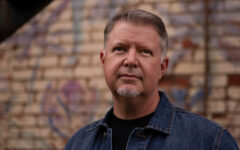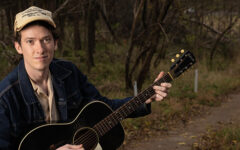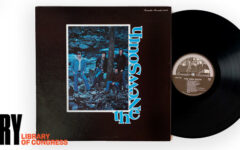 Today (2/26) marks the widely-anticipated release of Punch, the debut recording of Chris Thile’s touring band, Punch Brothers. Of course he recorded once before with this same unit on his How To Grow A Woman From The Ground CD, but they were then known as How To Grow A Band.
Today (2/26) marks the widely-anticipated release of Punch, the debut recording of Chris Thile’s touring band, Punch Brothers. Of course he recorded once before with this same unit on his How To Grow A Woman From The Ground CD, but they were then known as How To Grow A Band.
With Punch, the band has a new name, a new label (Nonesuch) and a new raison d’?™tre, to wit, Chris’ lengthy composition in four movements, The Blind Leaving The Blind, which forms the major portion of this new project.
We’ve written a good bit about this project on Bluegrass Today, including Brance’s recent three part interview with both Chris Thile and guitarist Chris Eldridge. Today, we celebrate the release of Punch in an interview with banjoist Noam Pikelny. Noam talks some more about the recording process and about performing this challenging material live.
You can hear two full pieces from Punch on the Nonesuch web site, audio samples from all 8 tracks on iTunes, and extended selections from each of the four movements of The Blind Leaving The Blind on Thile’s MySpace page. Chris and the Brothers will also be appearing on The Tonight Show with Jay Leno on Friday (2/29).
Here’s Noam on recording this CD…
We recorded at Legacy studio A509 in Manhattan. Our producer Steve Epstein suggested the room for the project. Once he signed on to the project he felt very strongly about having us in that room. And looking back on it all, I can see why. It’s absolutely beautiful. It’s quite large, but has amazing natural reverb and is a big part of the overall sound of Punch.We sat in a horse shoe type of shape, with [fiddler] Gabe [Wichter] and I opposite Critter [Chris Eldridge] and Thile, with [bassist] Greg [Garrison]at the bass of the “U”. We used no headphones and relied mainly on a 3 microphone tree about 10 feet above us. There were spot mics on each vocal and instrument that were used for balancing out the mix.
We recorded for about 5-6 days, from noon to 8 pm. We did multiple takes of everything on the record, but no overdubs. We played everything live in the room with no headphones. Typically we’d play a movement 5 or 6 times until Steve and the rest of us were confident we had everything we needed. At times we’d isolate certain sections and do several takes of them.
The recording process was actually very relaxed. We had worked on all the music for over a year, so it was all under our fingers, we just needed to capture the best possible performance in an ideal space. None of us in the band had worked with Steve Epstein before. He was suggested by Bob Hurwitz, the president of Nonesuch Records. He was invaluable to the recording. It was perfect to have someone come in who was fully comitted with amazing and fresh ears and an ability to focus on the big picture without comprising the details and nuances. Steve Epstein brought a long time musical partner of his, Richard King to engineer. They make an amazing team, and I’d love to work with them again.
I asked Noam about the other four pieces that make up Punch…
The Blind Leaving the Blind, the 40 minute composed piece in 4 movements, is written by Thile. But all the rest of the material on the record are co-writes. We got together in Bailey, CO a month or so before we were going into the studio to collaborate and solidify the songs that were going to balance out the record. Everyone brought bits and pieces of music that they were working on to see what we could put together. Chris wrote the lyrics for the non-instrumentals but everyone had a big part in the actual tunes and the arrangement. After spending so much time rehearsing “Blind,” was really exciting to sit down with everybody to share and write new music.
I was also curious about the reaction they receive when performing The Blind Leaving The Blind in concert.
We’ve gotten a great reaction to “Blind” at the live shows. In a couple of club and festival situations I think it didn’t connect with a handful of people, but as far as I can tell, people seem to be really into it and eager to get the record so they can become more familiar with the piece. We play “Blind” in its entirety in almost all of our shows. There are some situations where we’ll only feature some of the movements, but in most “listening room” gigs, we’ll play the whole piece in the first set.
I was also curious about the difficulty of the band playing such a complicated piece from memory.
At this point, the memorization is completed. We all committed to having the piece memorized before we played at Zankel Hall last year. I personally approached memorizing it in chunks. I’d work on about 30 seconds of music and would not move on practicing until I could play it without the score.
I’d say Blind is 75 % composed and 25 % improvised. The majority is written out in a score like a string quintet, but many sections read more like a chord chart, where we’re either playing an improvised solo, or backing up a vocal or someone else’s solo. Everything that is in the score is definitely intended to be played as written. Our parts are so intertwined that it makes it essential to adhere to the composition. But there are many sections where the parts aren’t so strict. That’s the case with the improvised solo sections, but also several sections have parts that are written out for each instrument like a vocal melody. I approach those just as if I was trying to play a kickoff or backup to a new song.
I’ve been enjoying this CD over several listenings since I first received a copy. It does ask a good bit of the listener, especially as compared to Chris’ prior release and the Nickel Creek CDs, but I think most folks who can appreciate the level of virtuosity on display will be glad they made the effort.







